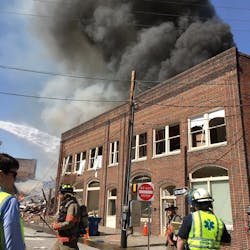NC Chief Explains Report Lag in Fatal Blast
By Dawn Baumgartner Vaughan and Tammy Grubb
Source The News & Observer (Raleigh, N.C.)
The city’s fire chief explained Wednesday why it took nearly a week to publicly disclose a 9-1-1 call reporting an odor of gas roughly an hour before the deadly April 10 gas explosion in downtown Durham.
The explosion and fire on North Duke Street near Brightleaf Square killed Kaffeinate coffee-shop owner Kong Lee and injured 25 others, including nine firefighters.
On Wednesday, a publicist for former U.S. senator John Edwards’ personal injury law firm announced the Lee family had retained the Raleigh firm, though no lawsuit has been filed. Edwards Kirby law firm was founded by Edwards, a two-time Democratic presidential candidate.
City officials initially reported a single 9-1-1 call coming in at 9:37 a.m. April 10 from a contractor who said he had hit a gas line.
The building at 115 N. Duke St. exploded at 10:07 a.m.
In an interview Wednesday Fire Chief Robert Zoldos said he only learned about the earlier 9-1-1 call this week, when news media outlets asked for recordings of other 9-1-1 calls about gas leaks reported April 10. The city publicly shared information about the call on Tuesday.
That earlier call came from a woman reporting a strong smell of gas as she drove through the North Duke and Morgan streets intersection.
There were several reasons, including the location provided by the first 9-1-1 caller, that the report of that earlier call was delayed by almost a week, Zoldos said.
The first caller reached 9-1-1 at 9:11 a.m. — roughly 26 minutes before the contractor’s call — and said she was near the Durham School of the Arts, between Corporation Street and Minerva Avenue, Zoldos said.
Equipment that tracks Durham’s fire engines showed Fire Engine 1 was dispatched from Station 1 on Morgan Street at 9:13 a.m., and the truck pulled out 13 seconds later, Zoldos said.
At 9:17 a.m., he said, the truck arrived at Duke and Morgan streets, where firefighters rolled down the windows and tried to smell for the gas odor. Finding nothing, he said, they pulled into the school’s parking lot and asked the 9-1-1 operator if the caller was still in the area. She already had left the scene, he said.
The firefighters stayed in the parking lot for just over two minutes, Zoldos said, and then drove around the block, taking Trinity Avenue, Gregson Street and Morgan Street. They parked again on Morgan Street, near the parking lot, he said, where they saw the gas release valves behind the Duke building at 710 W. Main St.
Thinking a normal release at the valves might have caused the smell, they returned to the station just a minute before the second call came in to 9-1-1, he said
Although he gets regular reports on major incidents, Zoldos said he would not have gotten information about a routine gas leak.
“We had to go look and see what that call was, and find out that it was related — and it was related, even though the address is a block away,” Zoldos said. “I get a summary of major incidents — this happened, a house fire happened and that sort of thing — this city runs a whole bunch of calls that happen. I’m responsible for them, but I don’t have a direct visibility until they’re of a serious nature.”
Firefighters who were first on the scene did not report answering the first call, Zoldos explained, initially because they were responding to the disaster and then because they had to recover from their own injuries suffered in the blast.
The debriefing with firefighters, in which the department will review its response to the explosion, began Wednesday, the chief said.
Zoldos did say it was unusual there were no more 9-1-1 calls after the contractor’s call.
“That’s a real anomaly in this response in that there’s no second, third, fourth, fifth calls,” he said. “I’m not sure the why on that or if the gas just found its path of least resistance into the Kaffeinate building, and it came out so rapidly there wasn’t that time. I don’t know, but it’s extremely weird.”
Zoldos also addressed questions about why gas-detecting equipment isn’t used to find gas leaks.
All fire engines have an Altair 4XR Gas Detector, which monitors the atmosphere in buildings and other closed-in spaces, such as trenches, Zoldos said. The monitors don’t work well in a wide area, he said, because the level of gas compared to oxygen and other elements would be lower in an open area, than in a closed one.
The monitor also requires gas to reach a certain threshold before the alarm is triggered, and its findings are delayed because of how the information is gathered and processed.
That makes a firefighter’s nose the best equipment for finding gas leaks, Zoldos said.
Although gas is odorless, manufacturers add a chemical called mercaptan to it, which gives gas a “horrible, nasty odor” meant to be detected by smell, he said. Fire crews that smell gas then use the Altair detector to monitor how much gas is in a location.
“You’re probably going to sense it by your nose before you get any real accumulation in the meter,” he said.
The state is continuing to investigate the gas leak and the explosion, Zoldos said. He noted that the equipment being used at the site before the explosion was 40 to 50 feet from the center of the building, which is a long way for the gas to travel.
The investigation “is going to be deliberate and slow, so they can give us good truth on that rather [than speculation],” he said.
———
©2019 The News & Observer (Raleigh, N.C.)
Visit The News & Observer (Raleigh, N.C.) at www.newsobserver.com
Distributed by Tribune Content Agency, LLC.






